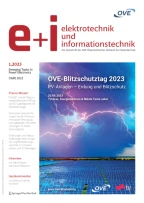Summary
Current automation solutions have a limited capability concerning agile adaptation to unexpected internal and external disturbances. Distributed intelligent control systems based on agent technologies are seen as a promising approach to handle the dynamics in large complex systems reducing the complexity, increasing flexibility and enhancing fault tolerance. We developed a new architecture of automation agents capable to answer the major requirements in the process domain. The application of these technologies enables efficient process scheduling, monitoring and diagnosis. Moreover, in the case of the changing production conditions, the presented system architecture enables a flexible automatic reconfiguration of the control software.
Zusammenfassung
Heutige Prozessautomatisierungslösungen haben limitierte Fähigkeiten hinsichtlich adaptiver Anpassung an unerwartete interne und externe Ereignisse. Auf Agententechnologie basierende verteilte, intelligente Steuerungssysteme werden als vielversprechender Ansatz gesehen, um die Dynamiken komplexer Systeme zu beherrschen und deren Flexibilität und Fehlertoleranz steigern zu können. Wir haben ein auf Automation Agents basierendes Multi-Agentensystem entwickelt, das den oben genannten Anforderungen der Prozessautomatisierung entspricht. Die Anwendung dieser Technologien ermöglicht effiziente Prozessplanung und Diagnosealgorithmen. Außerdem ermöglicht die präsentierte Systemarchitektur eine flexible automatische Rekonfiguration der Steuerungssoftware, um sich ändernde Produktionsbedingungen zu handhaben.
Similar content being viewed by others
Literatur
Bussmann, S., Schild, K. (2001): An agent-based approach to the control of flexible production systems. In: Emerging Technologies and Factory Automation, 2001. Proceedings. 2001 8th IEEE International Conference on, vol. 2, 2001, pp 481–488. [Online] Available: http://dx.doi.org/10.1109/ETFA.2001.997722
Bussman, S., Jennings, N. R., Wooldridge, M. (2004): Multiagent systems for manufacturing control: a design methodology, ser. Springer Series on Agent Technology. New York: Springer. [Online] Available: http://www.springer.com/978-3-540-20924-9
Helsinger, A., Thome, M., Wright, T. (2004): Cougaar: a scalable, distributed multi-agent architecture. In: Systems, Man and Cybernetics, 2004 IEEE International Conference on, vol. 2, pp 1910–1917. [Online] Available: http://dx.doi.org/10.1109/ICSMC.2004.1399959
Jennings, N., Bussmann, S. (2003): Agent-based control systems: why are they suited to engineering complex systems?. IEEE Control Syst. Mag., 23 (3): 61–73. [Online] Available: http://dx.doi.org/10.1109/MCS.2003.1200249
Koppensteiner, G., Merdan, M., Hegny, I., Weidenhausen, G. A change-direction-algorithm for distributed multi-agent transport systems. In: Mechatronics and Automation, 2008. ICMA 2008. IEEE International Conference on, 2008, pp 1030–1034
Leitão, P. (2009): Agent-based distributed manufacturing control: a state-of-the-art survey. Eng. Appl. Artif. Intell., 22 (7): 979–991. [Online] Available: http://dx.doi.org/10.1016/j.engappai
Lepuschitz, W., Zoitl, A., Vallée, M., Merdan, M. (2011): Towards selfreconfiguration of manufacturing systems using automation agents. Part C: Applications and Reviews. IEEE Trans. Syst. Man Cybern., 41 (1): 52–69. [Online] Available: http://dx.doi.org/10.1109/TSMCC.2010.2059012
Lesser, V., Decker, K., Wagner, T., Carver, N., Garvey, A., Horling, B., Neiman, D., Podorozhny, R., Prasad, M. N., Raja, A., Vincent, R., Xuan, P., Zhang, X. Q. (2004): Evolution of the GPGP/TÆMS Domain-Independent coordination framework. Autonomous Agents and Multi-Agent Systems, 9 (1): 87–143. [Online] Available: http://dx.doi.org/10.1023/B:AGNT.0000019690.28073.04
Maturana, F. P., Tichý, P., Šlechta, P., Discenzo, F., Staron, R. J., Hall, K. (2004): Distributed multi-agent architecture for automation systems. Expert Syst. Appl., 26 (1): 49–56. [Online] Available: http://dx.doi.org/10.1016/S0957-4174(03)00068-X
Merdan, M., Vallee, M., Lepuschitz, W., Zoitl, A. (2011): Monitoring and diagnostics of industrial systems using automation agents. Int. J. Prod. Res., 49 (5): 1497
Morel, G., Valckenaers, P., Faure, J., Pereira, C. E., Diedrich, C. (2007): Manufacturing plant control challenges and issues. Control Eng. Pract., 15 (11): 1321–1331. [Online] Available: http://dx.doi.org/10.1016/j.conengprac.2007.05.005
Müller, J. P. (1996): The Design of Intelligent Agents: A Layered Approach, ser. LNAI. Springer, vol. 1177. [Online] Available: http://dx.doi.org/10.1007/BFb0017806
Orozco, O., Martinez Lastra, J. (2007): A Real-Time interface for Agent-Based control. In: Industrial Embedded Systems, 2007. SIES ’07. International Symposium on, 2007, pp 49–54. [Online] Available: http://dx.doi.org/10.1109/SIES.2007.4297316
Padgham, L., Winikoff, M. (2003): Agent-Oriented Software Engineering III. Springer, ch. Prometheus: A Methodology for Developing Intelligent Agents, pp 174–185. [Online] Available: http://dx.doi.org/10.1007/3-540-36540-0 14
Pechoucek, M., Marik, V. (2008): Industrial deployment of multi-agent technologies: review and selected case studies. Autonomous Agents and Multi-Agent Systems, 17 (3): 397–431. [Online] Available: http://dx.doi.org/10.1007/s10458-008-9050-0
Pechoucek, M., Reh´k, M., Marík, V. (2005): Expectations and deployment of agent technology in manufacturing and defence: case studies. In: Proceedings of the fourth international joint conference on Autonomous agents and multiagent systems. The Netherlands: ACM, pp 100– 106. [Online] Available: http://dx.doi.org/10.1145/1082473.1082811
Sünder, C., Zoitl, A., Dutzler, C. (2006): Functional structure based modelling of automation systems. Int. J. Manuf. Res., 1 (4): 405–420. [Online] Available: http://dx.doi.org/10.1504/IJMR.2006.012253
Shen, W., Norrie, D. H. (1999): Agent-based systems for intelligent manufacturing: a state of-the-art survey. Int. J. Knowl. Inform. Syst., 1 (2): 129–156
Shen, W., Wang, L., Hao, Q. (2006): Agent-based distributed manufacturing process planning and scheduling: a state-of-the-art survey. Part C: Applications and Reviews. IEEE Trans. Syst. Man Cybern., 36 (4): 563–577. [Online] Available: http://dx.doi.org/10.1109/TSMCC.2006.874022
Sycara, K. (1998): Multiagent systems. AI Magazine, 19 (2): 79– 92. [Online] Available: http://www.aaai.org/AITopics/assets/PDF/AIMag19-02-2-article.pdf
Tharumarajah, A., Wells, A., Nemes, L. (1998): Comparison of emerging manufacturing concepts. In: Systems, Man, and Cybernetics, 1998. 1998 IEEE International Conference on, vol. 1, 1998, pp 325–331. [Online] Available: http://dx.doi.org/10.1109/ICSMC.1998.725430
Tichy, P., Slechta, P., Staron, R., Maturana, F., Hall, K. (2006): Multiagent technology for fault tolerance and flexible control. Part C: Applications and Reviews. IEEE Trans. Syst. Man Cybern., 36 (5): 700–704. [Online] Available: http://dx.doi.org/10.1109/TSMCC.2006.879381
Vallee, M., Merdan, M., Lepuschitz, W., Koppensteiner, G. (2011): Decentralized Reconfiguration of a Flexible Transportation System. In: Industrial Informatics. IEEE Trans. Ind. Inform., 7 (3): S.505–S.516.Iacocca Institute (1991) 21. Century Manufacturing Enterprise Strategy: An Industry-Led
Vrba, P., Marik, V. (2010): Capabilities of dynamic reconfiguration of multiagent-based industrial control systems. Part A: Syst. Humans. IEEE Trans. Syst. Man Cybern., 40 (2): 213–223. [Online] Available: 10.1109/TSMCA.2009.2034863
Vrba, P., Marik, V., Merdan, M. (2008): Physical deployment of agentbased industrial control solutions: Mast story. In: IEEE International Conference on Distributed Human-Machine Systems, Athens, Greece, pp 133–139
Zoitl, A. (2009): Real-Time Execution for IEC 61499. USA: ISA-o3neidaA, no. ISBN: 978193439-4274
Author information
Authors and Affiliations
Rights and permissions
About this article
Cite this article
Merdan, M., Zoitl, A., Koppensteiner, G. et al. Adaptive Produktionssysteme durch den Einsatz von autonomen Softwareagenten. Elektrotech. Inftech. 129, 53–58 (2012). https://doi.org/10.1007/s00502-012-0071-7
Received:
Accepted:
Issue Date:
DOI: https://doi.org/10.1007/s00502-012-0071-7
